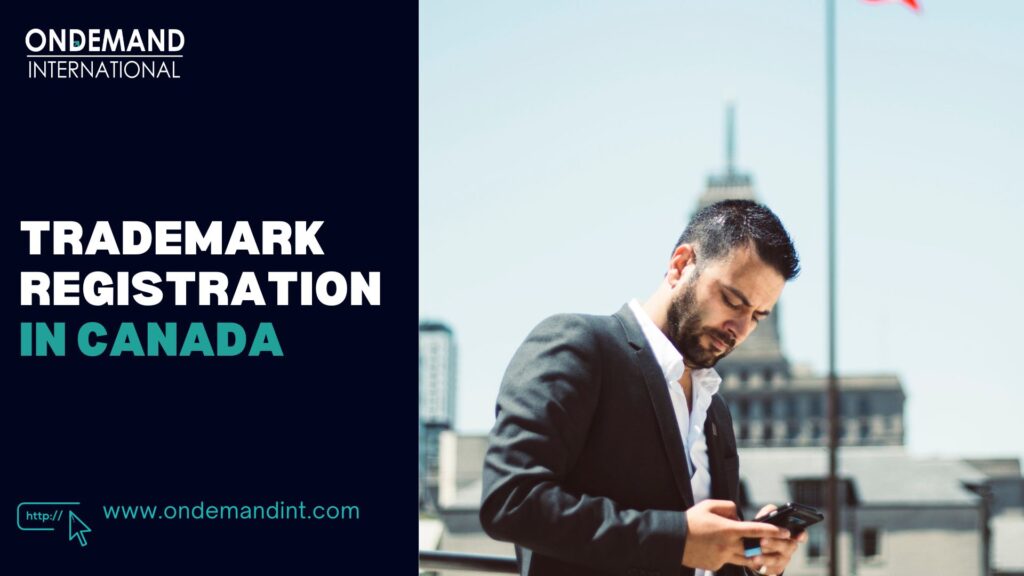
Trademark registration plays a pivotal role for businesses in Canada, acting as a legal safeguard for brand identity. Trademarks are more than just logos or names—they represent the reputation, trust, and values of a business. Whether you’re a small business owner or part of a large enterprise, protecting these assets ensures that your brand’s identity remains solely yours. In Canada, trademark registration can provide long-term security and open new avenues for growth. Let’s dive into the process, benefits, types, and renewal aspects of trademark registration in Canada.
Read More: Do you want to register your company in Canada?
What is a Trademark?
A trademark is a legally protected sign, symbol, logo, word, phrase, or combination thereof that represents and distinguishes the goods or services of a particular business from others. It serves as a form of intellectual property, which grants the owner exclusive rights to use the mark in connection with their products or services, ensuring that other businesses cannot legally use similar branding that could cause consumer confusion.
Key Elements of a Trademark in Canada:
- Distinctiveness: A trademark must be unique enough to distinguish your products or services from those of competitors.
- Exclusive Rights: Registered trademarks offer nationwide protection, granting exclusive rights across Canada.
- Variety of Forms: Trademarks in Canada include names, logos, slogans, sounds, shapes, and even colors or scents as long as they’re distinctly associated with a brand.
How to Register a Trademark in Canada?
Registering a trademark in Canada involves a comprehensive process managed by the Canadian Intellectual Property Office (CIPO). Here’s a step-by-step breakdown:
Step 1: Conduct a Trademark Search
A thorough search helps you avoid potential conflicts with existing trademarks and ensures your application won’t be rejected due to similarity. The Canadian Trademarks Database, available on the CIPO website, allows for preliminary searches. This step is critical, as CIPO has strict guidelines regarding trademark uniqueness.
Step 2: Determine the Type of Trademark
Canada categorizes trademarks into several types (covered in detail below), each with specific requirements. Identifying the right type upfront helps streamline your application process.
Step 3: Prepare and File Your Application
You can file your trademark application through the CIPO online portal or via paper submission. Here, you’ll need to:
- Provide a clear description of the trademark.
- Identify the goods or services associated with the trademark.
- Pay the initial application fee, which typically starts at CAD $330 for the first class and CAD $100 for each additional class of goods or services.
Step 4: Examination and Review Process
CIPO examiners review your application, looking for any potential issues or similarities with existing trademarks. If discrepancies or conflicts are found, CIPO will issue an office action, giving you a window to address these issues.
Step 5: Publication and Opposition Period
Once approved by CIPO, the trademark application is published in the Trademarks Journal. This allows the public to view it and file opposition if they believe it conflicts with their rights. The opposition period typically lasts 60 days.
Step 6: Registration and Certificate Issuance
If no oppositions are filed, or if they are resolved, CIPO issues a certificate of registration, officially granting you trademark rights in Canada. The entire process can take anywhere from 12 to 24 months, depending on the complexity of the application.
Read More: Planning to set up a branch/subsidiary in Canada?
Benefits of Trademark Registration in Canada
Exclusive Rights to Your Brand
A registered trademark grants you exclusive rights to use the brand name, logo, or slogan across Canada. This legal protection prevents others from using similar marks, thereby safeguarding your brand identity.
Enhanced Credibility and Trust
Customers recognize registered trademarks as symbols of trust. A registered trademark adds value to your brand, attracting more consumers and distinguishing your products or services from competitors.
Legal Recourse Against Infringement
With a registered trademark, you have the legal foundation to take action against unauthorized use or infringement. Without this registration, enforcing your rights can be challenging and costly.
Increased Valuation of Brand Assets
Registered trademarks are valuable assets. If you plan to expand, sell, or franchise your business, a registered trademark can increase its overall valuation, providing a strong return on investment.
Federal Coverage Across Canada
Trademark registration through CIPO grants federal protection, meaning your rights are recognized across all provinces and territories. This broad coverage is essential for companies expanding beyond local markets.
Types of Trademarks in Canada
Canada offers a variety of trademark types to protect different aspects of brand identity:
Ordinary Trademarks
This is the most common type, covering names, logos, symbols, or slogans unique to your business. Ordinary trademarks allow you to protect distinctive elements that differentiate your brand from competitors.
Certification Marks
Certification marks ensure that goods or services meet specific standards. They’re used by organizations to signify quality or compliance, such as eco-friendly or safety certifications.
Distinguishing Guises
These trademarks cover unique shapes or presentations of products. For example, the design of a bottle or packaging style may qualify if it serves to differentiate a product from competitors.
Sound and Other Non-Traditional Marks
With the modernization of Canada’s trademark laws, businesses can now register non-traditional trademarks like sounds, colors, scents, and textures, provided they can show that these elements distinguish the product or service.
How to Renew a Trademark in Canada?
Trademark registration in Canada lasts for ten years, after which renewal is required to maintain exclusive rights. The renewal process is straightforward but crucial for ensuring continued protection.
Step 1: Filing the Renewal Application
Approximately six months before your trademark’s expiration date, CIPO will send a renewal notice. You can submit the renewal application through CIPO’s online portal, including the necessary renewal fee, which is typically around CAD $400 for the first class of goods and services and CAD $125 for each additional class.
Step 2: Update Information if Necessary
If any information related to your trademark, such as ownership or address, has changed, updating it during the renewal process can avoid administrative issues down the road.
Step 3: Maintain Ongoing Use
To retain your trademark rights, ongoing use of the mark is essential. CIPO may request proof of use if they suspect non-use, particularly if a third party challenges the validity of your trademark.
Step 4: Secure Renewal Confirmation
Once renewed, CIPO will issue a renewal certificate, confirming your rights for another ten-year period. Ensuring that your trademark is continually renewed keeps your brand legally protected indefinitely, as long as you adhere to these requirements.
Difference between trademark and copyright in Canada
1. Definition and Purpose
- Trademark: A trademark is a sign, symbol, logo, word, or phrase that identifies and distinguishes the source of goods or services from those of others. Its primary purpose is to protect brand identity and prevent consumer confusion regarding the origin of products or services.
- Copyright: Copyright protects original works of authorship, including literary, dramatic, musical, and artistic works, as well as computer software and other creative expressions. The primary purpose of copyright is to give the creator exclusive rights to use, reproduce, and distribute their work.
2. What is Protected?
- Trademark: Trademarks protect brand identifiers, such as:
- Business names
- Logos
- Slogans
- Product packaging (trade dress)
- Copyright: Copyright protects the expression of ideas, not the ideas themselves. This includes:
- Books
- Music compositions
- Films and videos
- Artwork and photographs
- Software code
3. Duration of Protection
- Trademark: In Canada, a registered trademark is valid for 10 years and can be renewed indefinitely for additional 10-year terms as long as the trademark is in use and the renewal fees are paid.
- Copyright: Copyright generally lasts for the life of the creator plus 50 years after their death. For works created by corporations, the term is 50 years from the date of publication or creation. Recent changes have extended this duration in some cases to 70 years for works published after December 31, 2022.
4. Registration Process
- Trademark: Registration is not mandatory but is highly recommended for legal protection. The process involves a formal application to the Canadian Intellectual Property Office (CIPO), including a trademark search, examination, and publication for opposition.
- Copyright: Copyright protection is automatic upon the creation of a qualifying work. While registration with the Canadian Intellectual Property Office is available, it is not required to obtain copyright protection.
5. Infringement and Enforcement
- Trademark: Trademark infringement occurs when another party uses a mark that is confusingly similar to a registered trademark, leading to consumer confusion. Trademark owners must actively enforce their rights to maintain protection.
- Copyright: Copyright infringement happens when someone reproduces, distributes, or publicly performs a protected work without permission. Copyright owners have the right to take legal action against infringers, but enforcement often requires proof of ownership.
Conclusion
Trademark registration in Canada is a powerful tool for brand protection, offering exclusive rights, credibility, and increased business value. Navigating the registration process may seem complex, but the benefits it delivers far outweigh the effort and costs involved. By securing a trademark, you protect not only your brand’s identity but also its future growth potential, ensuring it remains uniquely yours in the Canadian marketplace.
If you’re ready to take the next step in protecting your brand, On Demand International is here to guide you through the trademark registration process and beyond. With our expertise, we’ll simplify the complexities, offering you strategic insights and support to successfully secure and leverage your brand assets. Contact On Demand International today to begin safeguarding your brand’s identity in Canada’s thriving business landscape.
Frequently Asked Question
How much time does it take to register a trademark in Canada?
The process of registering a trademark in Canada generally takes between 12 to 24 months from the initial application to approval. However, the timeline can vary based on several factors, such as the completeness of the application, potential objections or oppositions, and the workload of the Canadian Intellectual Property Office (CIPO).
How much does it cost for trademark registration in Canada?
The total cost of trademark registration in Canada can range from around CAD $400 to CAD $3,000 or more, depending on the number of classes, additional services, and professional assistance needed.
Can I register a trademark in Canada without a lawyer?
Yes, you can register a trademark in Canada without a lawyer, as the Canadian Intellectual Property Office (CIPO) allows individuals and businesses to apply independently. But hiring a lawyer isn’t required for trademark registration in Canada, it may provide added security for your brand’s protection if the trademark is complex or if you’re unfamiliar with intellectual property law.

